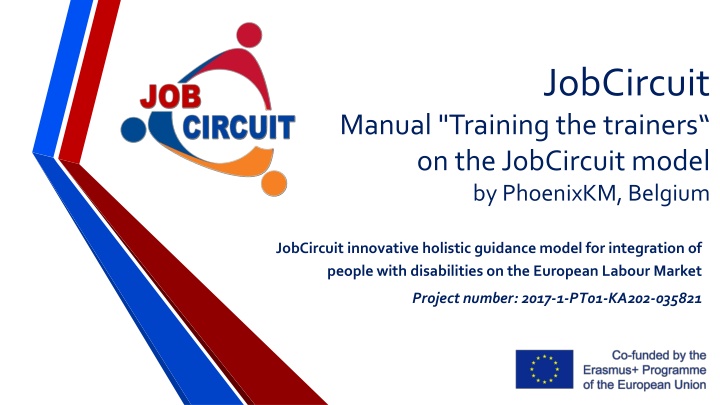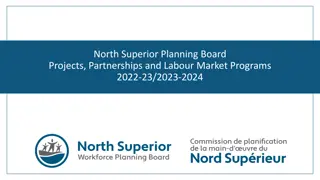Effective Training Manual for Integrating People with Disabilities into the European Labour Market
This comprehensive training manual provides guidance for trainers on implementing the innovative JobCircuit model by PhoenixKM, Belgium. It covers didactic guidance, planning and preparing training sessions, facilitating engaging training environments, and evaluating training impact. The manual outlines techniques for career guidance professionals and introduces strategies for successful training facilitation. It also includes information on exploring training needs, developing objectives, creating training schedules, and promoting positive attitudes towards career integration for individuals with disabilities.
Download Presentation

Please find below an Image/Link to download the presentation.
The content on the website is provided AS IS for your information and personal use only. It may not be sold, licensed, or shared on other websites without obtaining consent from the author.If you encounter any issues during the download, it is possible that the publisher has removed the file from their server.
You are allowed to download the files provided on this website for personal or commercial use, subject to the condition that they are used lawfully. All files are the property of their respective owners.
The content on the website is provided AS IS for your information and personal use only. It may not be sold, licensed, or shared on other websites without obtaining consent from the author.
E N D
Presentation Transcript
JobCircuit Manual "Training the trainers on the JobCircuit model by PhoenixKM, Belgium JobCircuit innovative holistic guidance model for integration of people with disabilities on the European Labour Market Project number: 2017-1-PT01-KA202-035821
What? This manualconsists of: Didactic guidance for trainer (training facilitators) who would like to train career guidance professionals on "how to use and implement the JobCircuit model Providing information to those who would like to introduce it by moderating learning group processes and discussions amongst different interest groups Providing training to new trainers, moderators and facilitators who are organising training sessions andmeetings.
Expected Impact Experience in planning andpreparing atraining session forVET learners Techniques and skills for a lively and positive atmosphere during a training facilitation Experience in the processes of providing a training session (e.g. lecturing and facilitating) Development ofself-critical awareness aboutpersonaltraining/facilitation style Techniques formonitoringandevaluating the successofthe training sessions
You as a trainee in the course You as trainer of other trainers
Intro on national legislation that defines what job circulation is allowed,for who, etc. To be provided by each partner
Content framework of the manual 1. Exploring training needs 2. Development of training objectives, outputs, topics, contents and inputs of a training workshop with career counsellors, vocational rehabilitators, supported employment consultants, job coachers, mentors 3. Training schedules and agenda 4. Organising the framework of training sessions - individualised or/and group session and online self-learning 5. Designing a training session 6. Basic approaches, techniques and skills to promote 7. Facilitating and debriefing of training activities 8. Monitoring and evaluation of the achievements 9. Creating awareness of attitudes and behaviour 10.Further facilitation in the field 11.References
1. Exploring training needs You as a training facilitator should explore the training needs via: Identification of existing level of knowledge of the trainers Identification of their training needs on the topic (Understanding) Creation of learning plan with attention on specific topics which desire further extension of knowledge Identification of the best way to provide practical activity to the trainers
2. Development of training objectives, outputs, topics, contents and inputs of a training workshop with career counsellors, vocational rehabilitators, supported employment consultants, job coachers, mentors As a training facilitator you need to ensure the development of training objectives for training workshops by taking into account the following principles: Principle 1: Utilise and stimulate the senses (sight, hearing, touch, taste, smell) Principle 2: Recognise the learning curve Principle 3: Don t abuse the attention span Principle 4: Encourage the effective use of memory Principle 5: Try to motivate students in their learning Principle 6: Accommodate different learning styles Principle 7: Ensure effective feedback in the learning process
3. Training schedules and agendas As a training facilitator, do produce a structured session plan that includes: Learning objectives - Identify exactly what successful learners should be able to do; - Make sense to learners who have not yet achieved the objectives or understood it. Lesson content adjust for each group of learners Instructional methods - Plan strategies that could be used to help learners to understand the content and develop competence; - Explain and demonstrate (do not read from handouts!) What teaching and learning resources will you need? - Audio-visual aids, JobCircuit mobile app, tasks for learners to complete and handouts, etc). Reflection activities and assessment approaches you should create questionnaire or implement case based assessment, production of an article, etc.)
The training plan created by you as a training facilitator should clearly show: the learning outcomes/topic objectives the organisation and development of content (lessons) the instructional methods to be used the use of teaching/learning aids and activities how learning impact is to be assessed
4. Organising the framework of training sessions - individualised or/and group session + online self-learning You as a training facilitator should use the following core instructional methods during face to face individualized/group sessions: Lecturing and explaining ( chalk and talk ) Demonstration (instructional strategies) Group work (cooperative learning) How to plan, introduce andconduct the group exercises: Questioning (tactics and responding to students) Discussion Case-studies (to capture real life situations with role play)
5. Designing a training session You as a training facilitator should design each training sessions (face-to- face/group), keeping in mind the following important pillars: Your motivation and the trainers motivation who you will instruct The relationships you have had with those trainers Your access to resources and time constraints Your and their mood and situational factors Their prior learning in a given area How you were taught How relevant you perceive the learning to be
6. Basic approaches, techniques and skills Give feedback sooner, rather than later Use feedback as a two-way process Incorporate the positive attitude (where possible) Recognise the trainers level of academic abilities and work experience in relation to the level of topics you intend to deliver Recognise your trainers level of attention span Accommodate to your trainers differing learning styles: -Visuals (objects, picture, diagram, words) -Auditory (oral explanations) - Kinaesthetic (doing the activity)
Action verbs are useful in describing a knowledge/skill Classifying Rule using Discriminating Problem solving toallocate to arrange to assign to catalogue to characterize to classify to collect to compile to define to describe to file to grade to group to identify to index to itemize to order to rank to reject to screen to sort to specify to survey to tabulate to calculate to calibrate to check to compute to convert to correct to deduce to design to determine to examine to expected to explain to extrapolate to foresee to illustrate to interpret to monitor to organize to plane to predict to prescribe to schedule to solve to translate to verify to accept to adjudicate to appraise to appreciate to arbitrate to assess to authenticate to choose to compare to criticize to discriminate to estimate to evaluate to gauge to judge to match to rate to recognize to review to value to weigh to accommodate to adapt to analyse to compose to conclude to construct to contrive to coordinate to correlate to create to develop to devise to diagnose to discover to find a way to generalize to infer to invent to programme to project to realise
7. Facilitating and debriefing of training activities You as a training facilitator should ensure an effective explanation by: Making clear statements and examples of what is being explained and its relevance to what learners need to know Organising information logically with appropriate examples and analogies to illustrate concepts and principles Linking key topics, concepts and principles Recapping key points at the end of each sub-topic Applying a clear and engaging style of presentation Supporting well-designed and appropriate teaching and learning aids Providing opportunities for student involvement
8. Monitoring and evaluation of the achievements You as a training facilitator should produce a scheme of monitoring/evaluation of achievements that identifies the following: When those activities will take place? What methods are to be employed? What marks/weighting are to be applied for each assessment (pre-, post-, self-)? Who is responsible for conducting those activities? What resources are needed ? What the conditions are under which assessments are to be conducted.
What can you as a training facilitator evaluate? Appropriateness of objectives for the learning group of trainers Organisation and sequencing of content Effectiveness of the instructional methods Quality of teaching and learning aids used Validity of assessment methods used The performance of trainers of the course
9. Creating awareness of attitudes and behaviour You as a training facilitator should: Detect the changes of attitudes and behaviour of your training group with regards to the JobCircuitholistic guidance model Analyse the strengths and weaknesses of the conducted training Create new opportunities for the inclusion of your learners into the society
10. Further facilitation in the field You as a training facilitator should: Take into consideration lessons learnt for the preparation of the next sessions with a new trainers group Provide in written your experience and observations to the local JobCircuit coordinators Request, if needed, from the other partners additional support on providing Train the trainers sessions
11. References Erickson et al, Disability Inclusive Employer Practices & Hiring of Individuals with Disabilities, Rehabilitation Research, Policy, & Education, p. 309-328, 309 v.28 (2014). Ph.D., R. Kauder, K. Krepcioand D. Baker. Ph.D., Ready and Able: Addressing Labor Market Needs and Building Productive Careers for People with Disabilities through Collaborative Approaches, pages 61-79 Recruiting, Hiring, Retaining, and Promoting people with disabilities - A resource guide for employers (Curb Cuts to the Middle Class Initiative)























